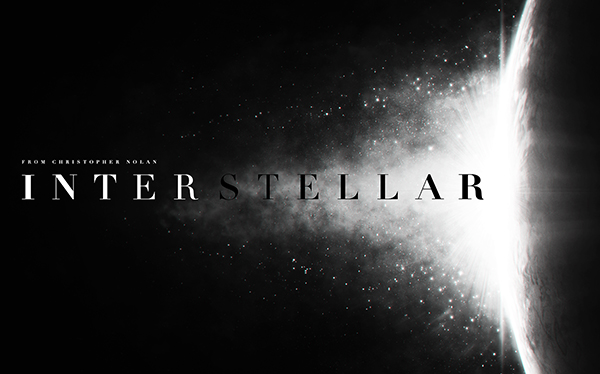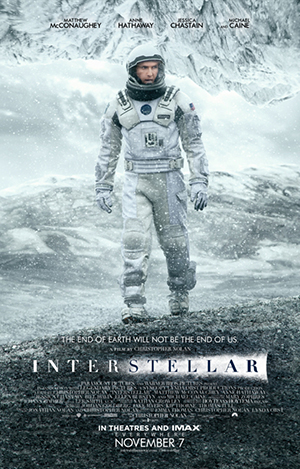Interstellar: Thoughtful sci-fi delivers love, evil, and a black hole

by Ted Giese
Christopher Nolan’s new film Interstellar is more like his 2010 film Inception than his trilogy of Batman movies. It’s both cerebral and emotionally intense. This is no Star Trek, Star Wars space opera (space-soap-opera); Interstellar is a more “hard” sci-fi film in the vein of Stanley Kubrick’s 2001: A Space Odyssey (1968) or Robert Wise’s adaptation of Michael Crichton’s The Andromeda Strain (1971).
Set in a near future where blight is devastating the earth’s food supply and starvation is wiping out the population, a former engineer and NASA pilot, Cooper, toils away on a farm with his two children and father growing corn—one of the few crops still viable for farming.
The future has become something like the Dirty Thirties on the North American prairies. Dust storms, food scarcity, and economic collapse have turned the remaining population into pragmatists who eschew the idea of spending money on things like universities and federal science programs like NASA. But NASA still operates in secret, and Cooper’s daughter Murphy (with the help of a mysterious external force she calls a “ghost”) discovers the co-ordinates of its top-secret installation—a secret installation no one was looking for.
Once inside the installation Cooper is convinced by Professor Brand to participate in NASA’s project to save humanity. Cooper makes the painful decision to leave his family behind to pilot a space craft called Endurance on an interstellar mission in the hope of finding a new world humanity can populate.
Resurrection, the Nature of Evil, and Love
 Professor Brand’s daughter is one of the astronauts on the space mission. However, the team is not venturing into space blindly; years earlier NASA had sent the Lazarus missions through a fortuitous worm hole which had appeared near the planet Saturn. Based on data received from those missions they believe they’ve narrowed down suitable worlds to further investigate. Upon hearing the name used for the previous missions, Cooper asks, “Why Lazarus?” Professor Brand replies, “Lazarus came back from the dead,” to which Cooper quips, “Yes, but he had to die first.”
Professor Brand’s daughter is one of the astronauts on the space mission. However, the team is not venturing into space blindly; years earlier NASA had sent the Lazarus missions through a fortuitous worm hole which had appeared near the planet Saturn. Based on data received from those missions they believe they’ve narrowed down suitable worlds to further investigate. Upon hearing the name used for the previous missions, Cooper asks, “Why Lazarus?” Professor Brand replies, “Lazarus came back from the dead,” to which Cooper quips, “Yes, but he had to die first.”
The allusion to Christ’s bringing Lazarus back from the dead (John 11) is one of the film’s few Scriptural references. While Christians have hope in Christ for their resurrection from the dead, the film’s hope for humanity is not divine intervention but rather hope that humanity will save itself through science. Still, Christian viewers might be interested in the way director Nolan tackles two big realities faced by humanity: evil and love. Through the lens of a purely materialistic scientific worldview, they are presented as a puzzle, sometimes making sense, other times running against the grain of rational thought.
While Christians have hope in Christ for their resurrection from the dead, the film’s hope for humanity is not divine intervention but rather hope that humanity will save itself through science.
In looking at evil, Professor Brand’s daughter acknowledges that nature can be frightening and dangerous, but she doesn’t believe nature contains evil. Neither does she expect to find evil in outer space. Rather, the only evil she expects to find is the evil humanity takes with it. On the one hand, Christian viewers will find Brand’s idea odd because Christians would look at the blight causing crop failure and starvation as the result of creation’s fall into sin. On the other hand Christians will recognize Brant’s idea about humanity taking evil with it wherever it goes because it sounds a lot like original sin. For Christians, sin and blight both have the same source (see the third chapter of Genesis).
One of the movie’s biggest sources of dramatic tension is found in the keeping/breaking of the eighth commandment: “You shall not bear false witness against your neighbour” (Deuteronomy 5:20). The evil of lies and falsehoods, told both in space and on earth, becomes pivotal to the survival of individual characters—indeed to all humanity. Conversely, Cooper works consistently out of love to make good on the promises he has made to his daughter Murphy before boarding Endurance and venturing into space. He wants to make sure his promises don’t become lies due to his failure to fulfil them. As a character Cooper tries to uphold the eighth commandment while other characters bear false witness for more or less noble reasons.
When looking at love, Professor Brand’s daughter at one point says, “Love is the one thing that transcends time and space.” It’s certainly driving Cooper and Brant. For them love is the very thing compelling them into action. At the same time there are characters who are driven by selfishness. Nolan presents both selfishness and love as kinds of survival mechanisms. Of the two, love is shown to be better than selfishness.
Hard Sci-Fi
Interstellar is one of those films that works best if viewers know little about it beforehand. It unfolds as a mystery. The “ghost” Murphy experiences in her bedroom brings questions: what is it or who is it or who are they? Likewise, what will the crew of Endurance find when they reach their destination?
For those who love “hard” sci-fi there’s a lot here to love. The film’s science focuses on physics, gravity and time in relation to Einstein’s theory of relativity. For the most part Nolan is gentle when presenting these ideas, and provides some exposition to assist viewers. Nolan is obviously concerned with accurately presenting the theories and concepts of modern astrophysics. With the help of Kip Thorne, a theoretical physicist, he handles a black hole and the nature of the black hole’s gravitational forces in a way never before depicted in film.
Based on the best mathematical equations of our day Interstellar looks at the black hole with a curious and imaginative eye asking what black holes are really like. The director’s presentation of space juxtaposed against humanity’s smallness in space will remind Christian viewers of Psalm 8:3-4: “When I look at Your heavens, the work of Your fingers, the moon and the stars, which You have set in place, what is man that You are mindful of him, and the son of man that You care for him?”
The director’s presentation of space juxtaposed against humanity’s smallness in space will remind Christian viewers of Psalm 8:3-4: “When I look at Your heavens, the work of Your fingers, the moon and the stars, which You have set in place, what is man that You are mindful of him, and the son of man that You care for him?”
Interstellar strikes a good balance between the chore of actually living in space with the stark but beautiful landscapes of imagined alien worlds. Plus, in the characters of TARS, CASE and KIPP Interstellar has some of the most engaging and compelling robots in recent film history.
Interstellar requires concentration from beginning to end; without it the last act of the film may be hard to follow. If this sounds to you about as fun as a root canal, then this film is not recommended. But if a heady sci-fi drama with a slow-burn pay-off is what you want, then Interstellar delivers.
While Interstellar is keenly driven by scientific themes it’s not without its poetry. Alongside its investigation into the nature of evil and love, the film at a number of points makes reference to the familiar Dylan Thomas poem “Do Not Go Gentle Into That Good Night” as a way of delving into the determination and character of humanity in the face of peril. A question any viewer might ask in watching Interstellar is this: “How do you respond when faced with death or the death of family and friends? Do you ‘Rage, rage against the dying of the light?’ And if you do, why do you do it: for evil reasons or for love?”
———————
Rev. Ted Giese is associate pastor at Mount Olive Lutheran Church in Regina. He reviews movies for both The Canadian Lutheran and Issues, Etc.



